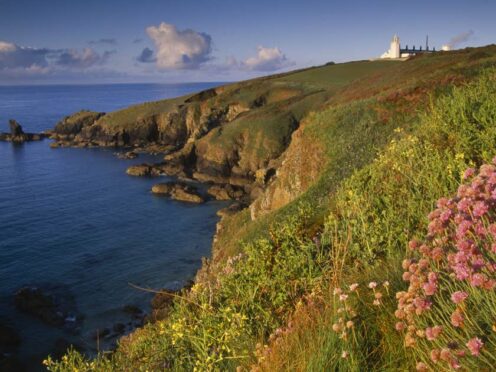
Rare coastal lichens, wildflowers and butterflies are being given a helping hand through the conservation and creation of “micro-habitats” across a landscape in Cornwall, the National Trust said.
The project aims to help wildlife recover across the entire 2,400 hectare (5,900 acre) Lizard National Nature Reserve, with many “Lizard specialities” found nowhere else in the UK.
The £350,000 project, funded by government agency Natural England, is focusing on conservation of micro-habitats on cliffs, bare rocks, in ditches, pools and tracks, where tiny lichens, liverworts and plants can be found.

Work in the reserve, where unique wildlife is found on semi-natural heathlands and grasslands and along the coastline, is targeting the recovery of 15 key species including rare, crusty lichens, wild asparagus, twin-headed clover and grayling butterflies.
Conservationists warn that although the Lizard is one of the most wildlife-rich places in the country, many species seem to be in decline or even facing extinction.
Species face the impacts of climate change, invasive species such as Hottentot fig which crowds out wild asparagus, and pollution, the National Trust said.
The charity is undertaking work including hand-clearing ivy from the serpentine rock of the Lizard – which is an important habitat for lichens – scrub clearance, digging ponds and creating scrapes for plants that need bare disturbed ground to germinate.

Controlled heathland burning and the cutting of firebreaks aims to boost plants such as bristle bent and sheep’s fescue that grayling butterfly caterpillars feed on.
The firebreaks will also protect isolated species from the affects of wildfires, which are on the rise as the climate warms, the National Trust said.
Pony and cattle grazing will also help create a mosaic of different heathland habitats for wildlife.
Seth Jackson, National Trust project manager, said a 2020 review suggested 40% of the most important plant species appeared to be in decline, and many such as twin-headed clover and dwarf rush had become fragmented and lost from up to 50 surveyed sites in just 40 years.
“The most important and urgent task is to expand wild populations, encourage natural recolonisation and cushion the expected impacts of climate change,” he said.
“Working closely with tenants, graziers and the local community will ensure a joined-up and long-term sustainable approach to habitat management, along with a programme of monitoring and surveys to improve the understanding of Lizard flora and fauna.
“Here on the Lizard, despite the wonderful landscape and the rich biodiversity it supports, we are not immune to the pressures that climate warming and habitat change bring, and many rare species are struggling.”
The funding will help protect species and microhabitats, and link the whole landscape together, he said.

Karen Shelley-Jones, Natural England species recovery programme manager, said: “We are delighted to be working with the National Trust on this project which epitomises what our species recovery programme is all about – delivering targeted bespoke action to reduce the risk of extinction for some of our most threatened and often overlooked species.”
Andrew Byfield, technical adviser to the National Trust, added: “The Lizard is one of the most exciting lowland coastal landscapes in the county, with a great many nationally rare and threatened species.
“By addressing the fate of these threatened plants and animals that together make this place so special, the project is also protecting the whole landscape, and also supporting the more common ones.”

Enjoy the convenience of having The Sunday Post delivered as a digital ePaper straight to your smartphone, tablet or computer.
Subscribe for only £5.49 a month and enjoy all the benefits of the printed paper as a digital replica.
Subscribe